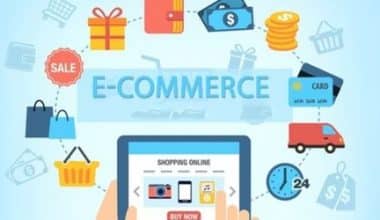A company that sells things online is known as e-commerce. It’s the same as an internet store. These products can be physical, such as shoes, cosmetics, literature, groceries, etc. Or they can be online courses, training programs and memberships, ready meal subscriptions, renting fashion items, and so on.
A direct-to-consumer business sells exclusively its own items through a website. Your business strategy is hybrid if you have both a physical store and an internet store. E-commerce shops can sell things from other brands that they do not manufacture.
Now that you know where you are in the realm of online selling, let’s get into marketing your ecommerce firm.
Steps To eCommerce Marketing Plan Documentation
Document your ecommerce marketing plan before designing an eCommerce marketing strategy, as it will serve as a guide for executing the strategy.
Step #1: Define Goals and Objectives for Your Store
If you are a complete beginner, begin by creating goals for your new E-commerce store – research conversion rates in your niche/industry.
Opens a new window and sets the goals and objectives. Establishing ambitious goals without considering what is currently working in the sector may lead to disappointment when the results are reviewed later.
Current retailers should assess their present performance and compare it to industry norms. If performance is below industry norms, defining goals as the mean of current performance and industry standards is the best option. If your performance exceeds expectations, you might establish higher goals based on your marketing budget.
Step #2: Evaluate Your Audience and Competitors
Do you know your ideal customers? If so, what are their qualities, interests, purchasing power, and other demographic, regional, and psychographic features?
Gather all of this data to construct multiple buyer personas. Understanding your ideal clients will assist you in determining the best conversion funnel for you.
Keep an eye on competitor activity at the same time to discover what works for them. Are they spending a lot of money on Facebook advertisements or making YouTube videos? Utilize this information to determine the best methods for launching your e-commerce marketing plan.
Step #3: Choose Marketing Strategy and Approaches
What initiatives can assist you in meeting your marketing objectives? Understanding this will enable you to select the marketing channels, as well as the proper techniques and methods, to ensure you meet your sales targets. If you are a B2C e-commerce store with lofty sales goals, you may need to invest heavily in social media marketing to reach your target demographic.
Once you’ve created a conversion funnel, it’ll be simple to identify which marketing channels will produce the best results at each level. For example, SEO will be critical during the awareness stage, whilst email marketing will keep your leads engaged during the interest and want stage.
Step 4: Create Your Martech Stack
A martech stack is a collection of software designed specifically for marketing. Get the tools and programs that make it simple to automate and manage marketing efforts on many channels to create a martech stack for your store.
Select products with extensive features to strengthen your martech stack. Aside from the e-commerce platform, for example, a Marketing Automation Platform (MAP) and a Customer Relationship Management (CRM) application will aid in the development of the framework for your marketing efforts. A full-featured MAP eliminates the need for additional email marketing and social media management tools.
Let’s look at the various marketing channels and recommended e-commerce tools for each category in the next section.
eCommerce Marketing Strategy Development
Operating an e-commerce store is a high-octane endeavor. There are numerous jobs to be completed at any given time, and automation is a must.
In this section, we will look at nine e-commerce marketing tactics that will help you achieve your objectives.
#1. Search Engine Optimization (SEO)
To rank organically on search engine result pages (SERP), you must have a solid SEO strategy. Here are a few things to think about to help your store rank higher on search engines:
- Make your website mobile-friendly.
- Improve page load time (Google PageSpeed Insights).
- Do an SEO audit (Ubersuggest)
- Do extensive keyword research and determine the terms for which you wish to rank (Google Keyword Planner).
- List all product, category, and blog entries and pages. Correlate target keywords and keyword phrases to each post and page, and strategically insert them in on-page elements such as the title, URL, header tags, text, alt text, anchor link, and so on.
- Create a Google My Business profile to boost your local SEO game.
- Resolve technical SEO issues such as duplicate pages. If necessary, seek the assistance of an SEO specialist.
- Set up your website in Google Search Console.
Other SEO Tools That We Suggest
- SEMrush
- Moz
- Keyword Explorer
- Ahrefs Site Explorer
#2. Content Marketing
In this section, we will go through the concept of on-page SEO in further detail. Product, category, and cart pages are all included in content marketing for e-commerce websites. Copywriting is a vital component of e-commerce marketing because it helps to efficiently drive conversions.
Let’s have a look at the various places where content marketing can be used:
- Product pages: This includes a headline, a product description, high-resolution photos, and demo videos.
- Blog Section: Develop valuable and interesting articles for your prospects and customers based on your niche. Examples include blog entries, downloadable content, infographics, checklists, and so forth.
- Rich Media: There is a lot of room for e-commerce storytelling. Create content using videos, podcasts, or other interactive media.
Tools for Content Marketing
- Feedly
- Buzzsumo
- Google Trends
- Grammarly
- Uberflip
#3. Email Marketing
If you use email marketing wisely, you may drastically increase your conversion rates. Regardless of how many ‘Email is Dead’ articles appear from time to time, email remains a dominant force in e-commerce marketing.
You may increase your list-building efforts with savvy marketing strategies. For example, entice website visitors to join your email list by providing downloadable information or by carefully putting lead generation tools (header bars, pop-ups, etc.).
You may start the proper email sequence after they join your list or enter their email address during checkout. These are some examples of emails you could send:
- A welcome sequence (drip email campaign) for new subscribers
- Transactional emails that bring buyers up to date on their purchases (such as order confirmation, receipts/invoices, shipment, delivery confirmation, and returns/exchange emails)
- Promotional emails are sent out on occasion to promote upselling or cross-selling opportunities.
Tools for Email Marketing
- Mailchimp
- ConvertKit
- ActiveCampaign
- GetResponse
#4. Social Media Marketing
One of the areas that have benefited greatly from social media is e-commerce. The reason for this is that product ads are not always regarded as an intrusion while skimming through social media.
Social media is particularly perfect for e-commerce since it is a visual medium, making it simple to persuade people using images and videos.
The emergence of social commerce platforms such as Instagram Shopping will help your e-commerce marketing efforts in the future, in addition to the liberal use of social ads to reach your target audience.
Tools for Social Media
- HootSuite
- Sprout Social
- AdEspresso
- Buffer
#5. Paid Promotion
Once your organic reach has maxed, your e-commerce business revenue becomes a function of the money you spend on ads. As a result, practically every successful online store invests substantially in paid advertisements (search ads, social network ads, native ads, and so on) that target each stage of the buyer’s journey.
Here’s how you can start with paid advertising:
- Spend money on search advertisements and Google Shopping ads to reach the awareness stage.
- Remarketing advertising allows you to reach out to customers who visited your website but did not complete a purchase.
- Using lookalike audience ads, you can broaden your target demographic.
#6. Marketing Influencers
Trusted individuals have an impact on people. Consumers are more likely to trust a celebrity or an expert in their niche than a brand, which is why e-commerce firms are investing in influencer marketing.
With influencer marketing, you work with celebrities or individuals that have a large fan base to act as brand ambassadors. You offer them content restrictions in order to avoid being too aggressive about your items. You evaluate their performance when they distribute the content on their social media profiles.
Influencer Marketing Tools:
- Followerwonk
- Kred
- HypeAuditor
#7. Conversion Rates Optimization (CRO)
The conversion rate is likely the most crucial indicator for any e-commerce site. It is the number of converted visitors per hundred visitors. Here are four strategies for increasing e-commerce store conversion rates:
- Recommendation Engine: Recommendation engines personalize the buying experience by recommending products to visitors based on their purchase and website viewing history.
- Cart Abandonment: Cart abandonment software sends emails to customers who leave a website without completing their purchase. E-commerce systems like Big Commerce include this feature as part of their package.
- Lead Generation: Using exit intent pop-ups, opt-in forms, and social proof notifications, these tools assist you in guiding customers along the conversion funnel.
Tools for CRO
- Sumo
- OptinMonster
- TrustPulse
#8. Consumer Service and Support
Internet retailers may experience logistical issues, resulting in unhappy clients who are concerned about their orders. To properly address this, e-commerce stores must have a responsive customer support department in place.
Customers should be able to contact you via phone, email, or live chat. In addition to traditional means, e-commerce stores must experiment with conversational AI so that they can connect with customers in real time via digital assistants, messenger applications, and chatbots.
Customer Service Tools
- Best Help
- Zendesk
- Freshdesk
- Intercom
#9. Analytical Marketing
Testing various sections of your website is an important feature of CRO. Tracking store performance also allows you to assess the impact of these adjustments.
You can track all of these aspects with the aid of analytics tools. Visits, conversions, page views, bounce rate, and other quantitative data are measured by quantitative analytics tools.
On the other hand, a qualitative analytics tool uses heatmaps, user session records, and funnel visualization to execute A/B testing and understand the qualitative performance of the website.
Top Marketing Analytics Tools
- Google Analytics
- HotjarOptimizely
- Crazy Egg
- Kissmetrics
Implementing an eCommerce Marketing Strategy
By this time, you should have a firm grasp on the minor subtleties that distinguish your company.
If you’re a tiny firm or even an online retailer, this is when you create the basis for future growth, and if you’re more established, this is how you accelerate your growth trajectory:
#1. Establish your sales and lead creation strategy.
Because there are no one-size-fits-all solutions, you’ll have to get creative. Potentially infinite marketing strategies exist for your company.
Despite the fact that the vast amount of digital marketing buzzwords can make your head spin, we’ll highlight methods and marketing tools with established track records of success, as well as some newer strategies to explore.
Consider a sales funnel diagram that depicts your clients’ journey from Awareness to Interest to Desire to Action. Each stage of this process should include notes about the precise marketing methods you’ll use to guide prospective clients through the funnel.
At the top of the funnel, you’ll notice e-commerce brand awareness-building techniques that don’t always result in quick sales, such as posting organic social content or programmatic display ads. At the bottom, you’ll find Google search network adverts, Instagram retargeting ads, and direct email communication.
As a marketer, you should think about the primary goal of each campaign strategy you use and where it fits in your funnel.
#2. Obtain reporting and technological software.
Before launching a meaningful marketing campaign, you must be able to answer the following questions:
Is the technology I’m now employing to track the efficacy of my marketing activities adequate?
Can it be used to see if the KPIs I’m attempting to improve are improving?
Will it assist our team in effectively calculating the ROI of our actions?
As previously said, the sheer number of marketing channels continues to grow, and the tools you use to track that data must be adequate.
Consider these useful tools:
- Google Data Studio (integrations for free and for a fee).
- LuckyOrange.
- Start with conversions.
There should be specific bottom-of-the-funnel methods in your lead generation and sales funnel plan to help clients cross the finish line. Launch these efforts initially to create sales and develop momentum.
At the end of the day, conversion rates are among the most valuable statistics for an e-commerce firm, and understanding them is critical to your company’s long-term success.
#3. Test the waters.
Set aside a portion of your e-commerce marketing budget to experiment with different techniques. After all, you won’t know what works and what doesn’t unless you try it.
Depending on your budget, performing some simple test cases in smaller markets can give you the artillery you need to justify a budget increase, validate previous recommendations, and/or open the door to a completely new market opportunity.
#4. Improve and broaden your eCommerce marketing strategy.
Once you’ve gained traction, you’re ready to refine and grow your ecommerce marketing strategy. You should now have a clear knowledge of what works, what needs to be improved, and what opportunities exist.
As a result, by raising your budget and scaling up, you may refine and scale up your first strategy. This is where you can be really creative.
Consider the following strategies:
- Partnerships and Joint Ventures: Partnerships have helped complementary brands succeed. You can collaborate to develop content that exposes both brands to each other’s email lists, or you can combine numerous brands to create a curated Christmas gift package. When brands align, both brands benefit.
- Raise Average Order Value (AOV): Once you’ve established a continuous sales stream, it’s essential to boost the average order value. Tier your discount codes to encourage larger purchases, or provide expedited shipping for orders that are 50% more than your current AOV.
- Referrals: Give current and loyal customers the chance to suggest a friend and reap the rewards. If your customers had a positive experience, they may become an army of brand evangelists.
Read Also: WHAT IS MARTECH? Importance and Best Practices
What is the Difference Between E-commerce and Digital Marketing?
Ecommerce is a method of selling and delivering goods and services. Digital marketing is a method of reaching out to new and present customers in order to drive purchases. When someone visits your website to purchase new shoes, the act of purchasing and receiving the shoes is referred to as ecommerce.
How Do You Market an Online Store?
- Social Media Marketing
- Search engine marketing
- Affiliate promotion
- Influencer advertising
- Email promotion
- Marketing on a local level
- Loyalty schemes
- Optimization of conversion rates
- Pay-per-click marketing
- Emails from abandoned shopping carts
Conclusion
It may appear difficult to create a well-thought-out ecommerce marketing strategy.
But, the number of tactics and platforms available to assist promote online sales is vast and growing. While you may be tempted to hurry ahead, being deliberate is essential when building an ecommerce marketing strategy.
Make sure you have a thorough understanding of your product and market needs and don’t be hesitant to make assumptions as long as you test them.
E-commerce marketers may feel like children in a candy store, deciding which new tastes to sample today. It’s difficult to go wrong if you’re organized, detail-oriented, and eager to learn.
Related Articles
- E-Commerce Explained: Types, Examples, And Advantages
- MARKETING VS SALES: What Are the Major Differences?
- SALES FUNNEL: Definition, Types, and What You Must Know
- The Best SMALL E-COMMERCE BUSINESS Ideas in 2023 (+ How to Start)
- SALES FUNNEL Meaning, Stages, Template & All You Need






